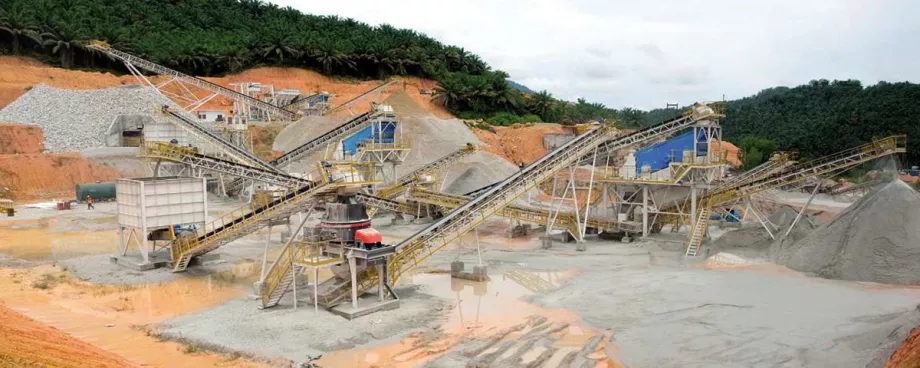Leading quarrying companies are now placing increasing emphasis on the highest possible standards of safe, efficient and productive operations. When these three aims were combined as the primary criteria for their latest aggregate quarry plant, Lafarge Aggregates Malaysia sought a partner who could deliver the high quality aimed for, whilst meeting what are traditionally seen as incompatible goals. Finally, the contract was awarded to Sandvik Mining and Construction Malaysia, who have recently designed and installed the 250 tonnes per hour fourstage crushing and screening plant located in Kulai, Johor, Malaysia, approx. 270 kilometres south of Kuala Lumpur.
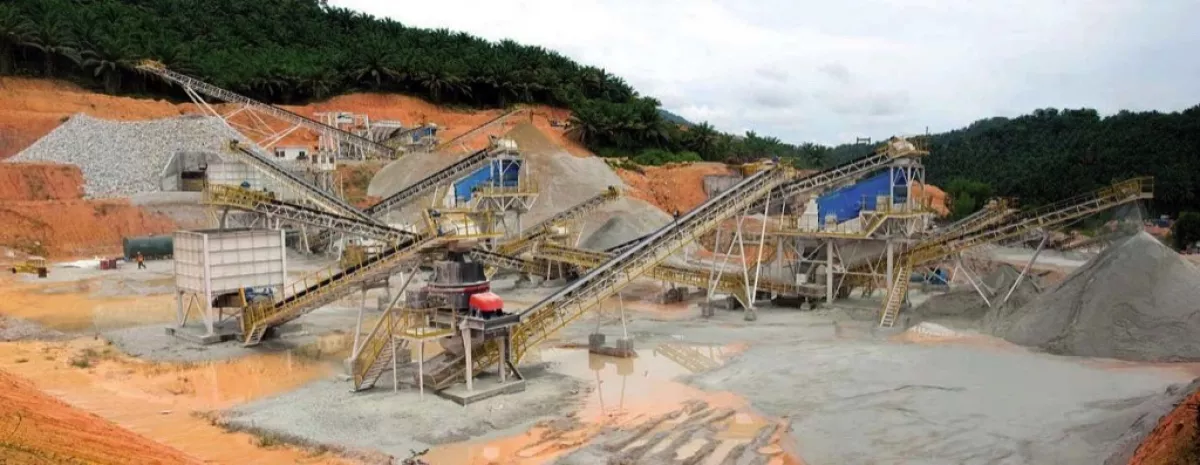
Malaysia is proving to be a strategically important market for Lafarge Aggregates, and the new plant will play a key role in providing high quality aggregates for the expansive Malaysian construction industry. The initial problem for Lafarge however was to not only install an aggregates plant capable of producing high quality end products, at high rates of production, but also to be able to combine this required productivity with the highest possible standards of efficient, safe operation.
Safety and Efficiency
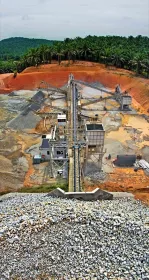
With the aim of establishing an aggregate plant that would be highly productive, and, at the same time, would also operate to the highest standards of efficiency, whilst simultaneously ensuring that operational safety is at a premium, Lafarge sought for a partner to help in the design of the plant, as wel I as to construct it, and ensure that its operation would match the high standards of the initial design.
In the end, Lafarge Aggregates Malaysia chose Sandvik Mining and Construction Malaysia as their partner of choice in this project, knowing that the company possess extensive turn-key project expertise, which is also matched with local experience. Furthermore Sandvik is an acknowledged as one of the world leaders when it comes to combining operational requirements with the highest standards of plant safety and environmental focus.
The driving force behind the plant design came from Lafarge Aggregates Malaysia’s emphasis in ensuring that the Kulai plant would be able to satisfy market demand for aggregates, but also that operational safety was endemic from the very start.
Thus, the initial specification for the plant reflected this commitment that would be continued during the construction and operation (if Lafarge required further proof that they had made the right choice in selecting Sandvik to design and construct their plant, then it was noted that during the build there were no instances of injury, and that the plant was operational well ahead of schedule) of the plant.
This commitment has brought uniqueness to the plant, with this being shown by the concrete surge tunnel being extended; thereby facilitating openings from both sides, thus allowing for easier escape on either side should an emergency occur. Furthermore, walkways are wider than normal which allows for safer mobility, as well as enabling easier maintenance access.
The finished plant possesses numerous other safety features that have been incorporated from the initial design concept, with many ideas resulting from the innovative thinking of Lafarge Aggregates Malaysia, and specifically the Kulai Quarry project team, with additional invaluable input from the Lafarge Health and Safety Department.
Crushing and Screening
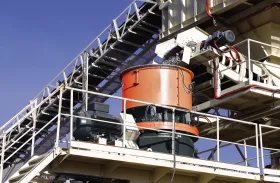
The fully constructed aggregate plant now comprises of some of the company’s most advanced breaking, crushing, screening and feeding equipment. At the very heart of the operation is a Sandvik CJ412 primary jaw crusher, a CS430 secondary cone crusher, a CH440 tertiary cone crusher and a CV228 quaternary vertical shaft impactor.
This equipment, when combined into the state of the art plant design, has the capability to efficiently produce five different products at the required production rate of 250 tonnes per hour. The five products produced comprises of:
- ballast rocks,
- road base material,
- 10 to 20 millimetres aggregates,
- 5 to 10 millimetres aggregates, and
- manufactured sand.
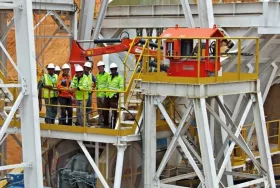
The end products themselves are used throughout the Malaysian construction industry, with specific uses being found in ready-mix production, pre-cast requirements, road construction and general building work. What proved to be of particular interest is that although the plant has been designed to be capable of producing a 0 to 20 millimetres product at 250 tonnes per hour, but Lafarge testing of the plant has proved to it to be capable of producing a this product at a production rate of 291.2 tonnes per hour.
High Production Capacity
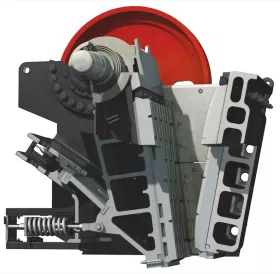
One of the reasons for the plants high capacity is due to the principle cone crusher used being the Sandvik CH440. Lafarge chose this cone crusher because of its special design, due to which the machine possesses a high capacity in relation to size, a high reduction efficiency and produces a very consistent product shape. With hydraulically adjusted CSS (Closed Side Setting), optional automation, a choice of several different crushing chambers, and many other high performance features, the system is versatile, user friendly and highly productive.
Another piece of crushing equipment that has been instrumental in the success of the Lafarge Kulai aggregate plant is the CV228 VSI. This advanced piece of equipment is part of the CV200 series, which has been developed to ensure that product shape and size are consistent. However, the innovative nature of the design also produces reduced power consumption, increased capacities, reduced maintenance costs, and vitally, requires fewer maintenance services.
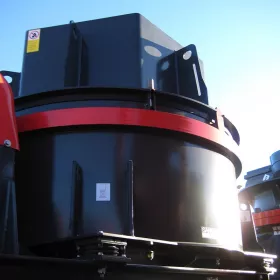
The system has been primarily designed to operate as a third or fourth stage crusher, proving it to be ideal for Lafarge’s manufactured sand application. Vitally Sandvik’s patented autogenous “rock on rock” crushing technique results in several major advantages in the production of manufactured sand, with perhaps the most important for Lafarge being the consistently cubical product shape, which results from the extremely low flake and elongation values.
Due to the design of the VSI product gradation remains constant even as rotor wear parts wear, thus ensuring that contamination rates are extremely low as no wear parts are used to directly crush the rock. It is worthy of note that the autogenous crushing technique used in the crushing process not only mirrors the work of nature, but provides significant benefits in cement production due to the shape of the final sand product.
An additional, but no less important benefit is the low environmental impact of the Sandvik VSI. The CV228, and the CV200 series as a whole, utilise Sandvik’s patented Bi-Flow system and high performance rotors. These are used in conjunction with the second generation wear parts that have resulted in significant power reductions, yet capable of producing higher tonnage throughputs despite this reduction in power.
The result of this development is that up to 20 percent of the maximum crusher throughput can be effectively handled through the Bi-Flow system, thus producing a significant saving in electricity costs and lowering of Lafarge’s C02-emissions per tonne.
Additional Equipment
Although the crushing plant is at the heart of Lafarge’s aggregate plant, further Sandvik equipment has been used thereby maximising productivity, safety and efficiency. This additional equipment includes a grizzly feeder, two vibrating screens, and a hydraulic breaker. There is also an additional hydraulic breaker at the primary production stage of the plant incorporated as an additional safety feature, and a boom system mounted on the primary opening.
All of the mentioned factors mean that Lafarge is now helping to satisfy the needs of the Malaysian construction industry through the supply of a high-quality product, operate in a more environmentally focused manner, safely, whilst experiencing high levels of efficiency and productivity.
Malaysia’s ambitious and huge infrastructure development in the south of the country, such as the lskandar Corridor, and Singapore’s insatiable demand for building materials, will surely benefit from Lafarge Aggregates Malaysia’s new plant; this new plant with its intelligent design, and state of the art equipment, proves that modern aggregate plants can maximise safety, production flexibility and efficiency at the same time.
■



